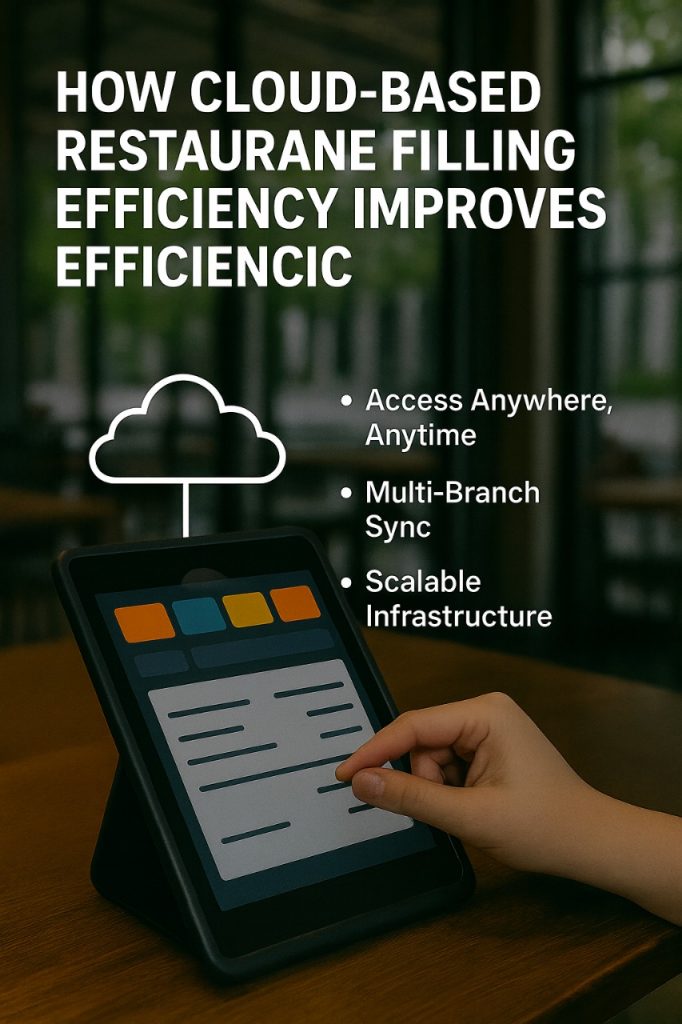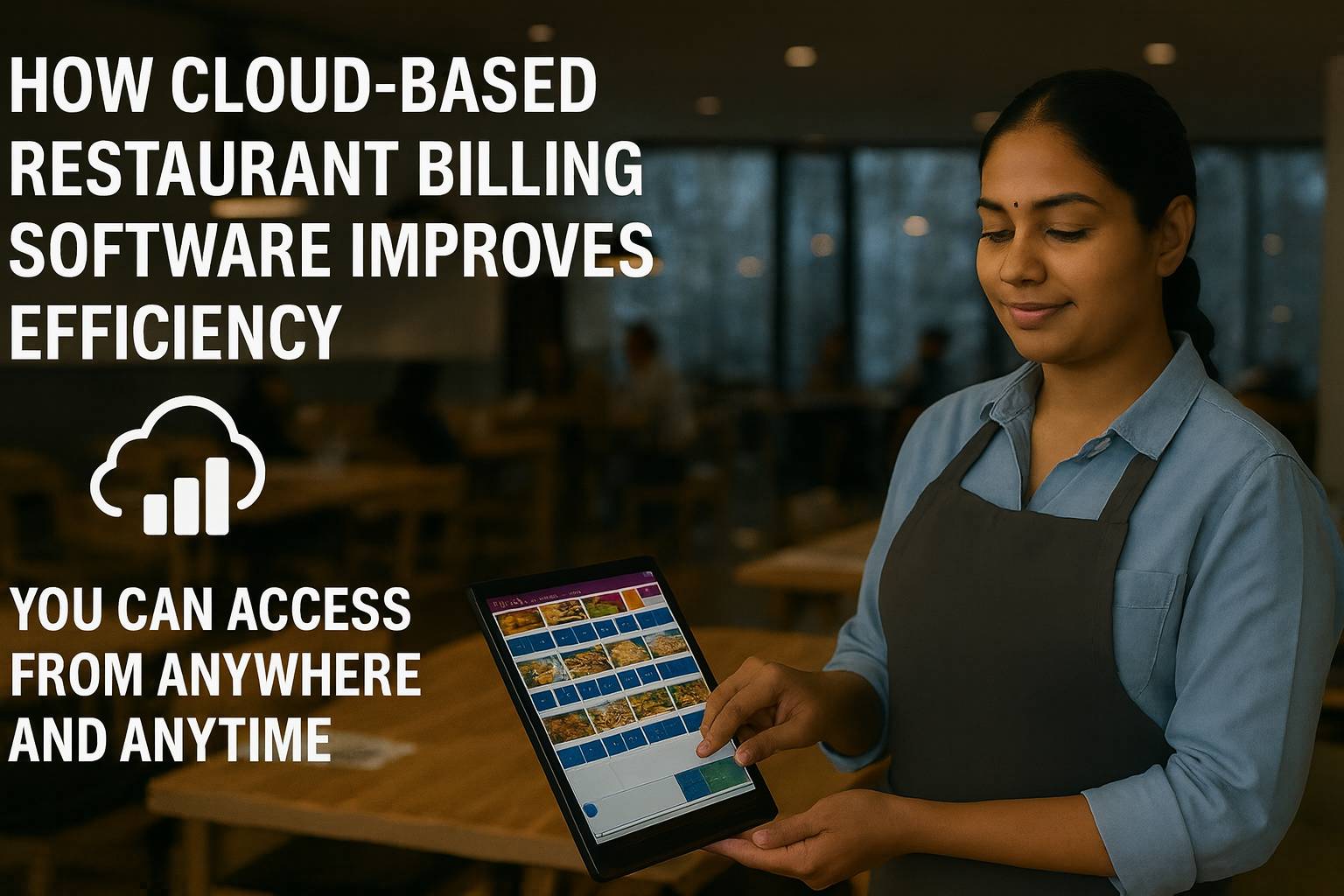Why Efficiency is the New Currency in Restaurants
The restaurant business has always been fast-paced, but in the last decade, the pressure to operate more efficiently has intensified. Rising customer expectations, increasing competition, and rapid technological advancements have forced restaurant owners to rethink how they run their operations.
In the past, the focus was simple — provide great food and friendly service, and the rest would take care of itself. Today, that’s no longer enough. Customers not only expect quality but also speed, accuracy, flexibility, and convenience. A slow or clumsy billing process, even if the meal was perfect, can sour the entire dining experience.
That’s why more and more restaurants are moving away from outdated billing methods and embracing cloud-based restaurant billing software — a solution that goes beyond printing bills to managing the heart of restaurant operations.
This technology doesn’t just make transactions faster. It connects the kitchen, waitstaff, management, and even delivery services into a single ecosystem, improving accuracy, cutting costs, and empowering managers with real-time insights. In this guide, we’ll explore how cloud-based billing software transforms efficiency in restaurants, the challenges it solves, and why it’s becoming essential for every modern food business.
Access Anywhere, Anytime — Manage Your Restaurant from Anywhere
One of the most powerful features of cloud-based systems is the ability to work remotely without being tied to a physical location.
- You can log in from a smartphone, tablet, or laptop, whether you’re at home, traveling, or managing multiple outlets.
- View real-time sales reports, staff performance metrics, and stock levels instantly.
- Approve discounts, manage menu updates, and track peak hour performance without stepping into the restaurant.
Example: A café owner traveling abroad can still monitor live orders in Bangalore, approve urgent purchases, and send promotional offers — all from their phone.
The Journey from Cash Registers to the Cloud
For decades, restaurant billing meant a cash register at the counter and handwritten order slips for the kitchen. This process was slow, error-prone, and difficult to track. In the 1990s and early 2000s, traditional POS systems emerged, allowing digital order entry and automated bill printing.
While this was a big step forward, traditional POS systems had major limitations:
- Data was stored locally, making it accessible only on-site.
- Reports had to be generated at the end of the day.
- Software updates required technicians and downtime.
- Hardware was expensive and inflexible.
- If the system crashed, valuable data could be lost.
By the mid-2010s, with the rise of high-speed internet and cloud storage, the restaurant industry saw the emergence of cloud-based POS systems. This shift was transformative. With the cloud, sales data, inventory levels, and customer records could be stored securely online, accessed from anywhere, and updated in real-time.
For the first time, restaurant owners could monitor and manage their business remotely — a capability that became even more crucial during the COVID-19 pandemic when many owners had to operate with minimal on-site presence.
The Operational Challenges Cloud Billing Solves
Before diving into the benefits, it’s worth understanding the specific operational headaches cloud billing addresses:
- Long Wait Times for Billing – Traditional systems often cause delays during peak hours, leading to long queues and frustrated customers.
- Inconsistent Data Across Locations – Multi-outlet restaurants struggle to maintain consistency in pricing, menus, and promotions.
- Limited Access to Information – Managers can’t make informed decisions without up-to-date sales and inventory data.
- High Maintenance Costs – Local server-based POS systems require regular maintenance and expensive hardware.
- Data Security Risks – On-site storage is vulnerable to theft, damage, or technical failure.
Cloud billing eliminates these inefficiencies with centralized, automated, and remotely accessible systems.

How Cloud-Based Billing Improves Efficiency Across the Restaurant Workflow
Faster Order Processing
Speed is critical in food service. In a traditional setup, orders are often taken on paper, entered into the POS, and then sent to the kitchen — each step adding delays. With a cloud-based POS, orders are entered directly into the system via a tablet or terminal and instantly transmitted to the kitchen display system (KDS).
For example, in a busy fine-dining restaurant, a waiter can take an order at the table and send it straight to the kitchen without leaving the customer’s side. The chef sees the order in real time, and preparation begins immediately. This eliminates redundant steps and cuts several minutes from each service cycle, improving table turnover.
Real-Time Access to Data
In the old model, managers often had to wait until closing time to see the day’s sales reports. By then, it was too late to adjust menus, staffing, or promotions. Cloud-based systems change this by updating all data instantly.
Imagine it’s lunchtime and your grilled chicken sandwich is selling out faster than expected. With real-time inventory tracking, you can see the trend emerging and take immediate action — either by prepping more or promoting another menu item before stock runs out.
Multi-Outlet Control from One Dashboard
For restaurant chains, managing multiple locations is a complex challenge. Without centralized control, each branch might have its own version of the menu, different prices, or inconsistent promotions. Cloud billing solves this by giving managers the ability to make updates once and push them to all outlets instantly.
This not only saves hours of repetitive work but also ensures that customers have a consistent experience no matter which branch they visit.
Reduced Hardware Costs and Maintenance
Traditional POS systems rely on specialized, often expensive hardware. Cloud POS runs on everyday devices like tablets, laptops, and even smartphones. Updates happen automatically over the internet, reducing the need for IT visits and keeping downtime to a minimum.
For smaller restaurants or startups, this can mean thousands of rupees in savings without sacrificing functionality.
Enhanced Security and Data Backup
Data loss can cripple a restaurant’s operations. Cloud POS providers store data on secure servers with encryption, regular backups, and disaster recovery systems. Even if your POS terminal is damaged or stolen, your information remains safe and can be accessed from another device within minutes.
Integrated Payment Processing
Customers today expect flexibility in how they pay. Cloud billing integrates with multiple payment gateways, enabling quick, secure transactions via UPI, debit/credit cards, digital wallets, and even QR codes.
This not only speeds up checkout but also reduces errors, since payments are automatically linked to the order in the system.
Streamlined Inventory Management
Every sale updates inventory levels automatically, giving managers a live picture of stock availability. The system can send alerts when ingredients are running low or approaching expiry. This minimizes waste, avoids stockouts, and keeps costs under control.
Better Staff Productivity
By automating routine tasks like order entry, bill generation, and inventory tracking, cloud billing frees staff to focus more on customer service. Waiters spend less time running between tables and the kitchen, while managers spend less time compiling reports.

Case Studies: Efficiency in Action
Case Study 1: The Quick-Service Boost
A quick-service restaurant in Pune reduced average order-to-delivery time from 15 minutes to 10 minutes after implementing a cloud POS. This allowed them to serve 20% more customers during peak hours without hiring additional staff.
Case Study 2: Multi-Outlet Synchronization
A café chain with six outlets used cloud billing to standardize menus and prices across locations. This improved brand consistency and cut admin time for updates by 80%.
Case Study 3: Data-Driven Decisions
A fine-dining restaurant in Bangalore used real-time sales data to identify underperforming dishes and replace them with new, more profitable options, increasing monthly revenue by 12%.
Financial Impact: ROI of Cloud Billing
Investing in cloud billing often pays for itself within months. Savings come from:
- Reduced hardware costs
- Lower IT maintenance expenses
- Faster service leading to more customers served
- Better inventory control reducing wastage
In one study, restaurants reported an average ROI of 150% within the first year of implementing cloud-based systems.
Challenges and How to Overcome Them
While the benefits are significant, transitioning to cloud billing can come with hurdles:
- Staff Training – Some employees may be resistant to change. Solution: Provide hands-on training and support.
- Internet Dependency – Cloud systems need stable internet. Solution: Choose software with offline capabilities.
- Initial Learning Curve – Like any new tool, it takes time to get used to. Solution: Roll out in stages and gather feedback.
The Future: AI, Automation, and Beyond
The next wave of cloud POS technology will integrate AI-driven sales forecasting, dynamic pricing based on demand, and voice-activated order taking. These innovations will make restaurants even more responsive and efficient, and those adopting them early will have a competitive advantage.
Contact Us for a Free Demo
At Zymofar Dynamic Products Pvt. Ltd., we specialize in powerful restaurant management solutions like Restro Pro — a cloud-based billing system that simplifies operations, boosts efficiency, and enhances customer satisfaction.
Whether you run a small café, a multi-branch restaurant, or a growing food chain, our software is tailored to meet your unique needs.
📞 Call / WhatsApp: +91 70903 35533
🌐 Website: https://zymofar.com
📧 Email: info@zymofar.com
💡 Book a free demo today and experience how Restro Pro can transform your restaurant operations.


